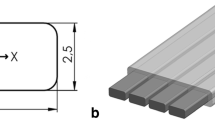Abstract
For ballistically impacted glass/epoxy cross-ply laminated plates with three five-layer unidirectional laminas, high-speed photos were taken from the back of plates, illuminated from the front side. The semitransparency of the plates enabled a Nova high-speed camera to record delamination-crack propagations at speeds of up to 40,000 frames/s. The delamination crack in the fiber direction of the first (second) lamina at the first (second) interface, propagated initially at 300–400 (400–500) m/s which decreased to 200–300 (270–400) m/s during the period of observation, and decelerated to a stop within 100 (300) μs. This last velocity range (270–400 m/s) agreed well with the largest-amplitude flexural-wave velocity measured by strain gages. This is a documentation that delamination is associated with the flexural wave.
A velocity gage consisting of a silver conductive paint was modified to measure propagation velocities of the generator strip which was cut from the first lamina by two through-the-thickness cracks and which initiated a sequential delamination. This generator-strip-formation velocity was higher than the measured delamination-crack-propagation velocity. This fact is consistent with the assumption that the generator strip initiates delamination cracks.
Similar content being viewed by others
References
Takeda, N., “Experimental Studies of the Delamination Mechanisms in Impacted Fiber-reinforced Composite Plates,” PhD dissertation, University of Florida (1980).
Takeda N., Sierakowski, R.L. andMalvern, L.E., “Experimental Impactor/Plate Configuration Interaction Studies of Impacted Glass Fiber-reinforced Composite Laminates,”SAMPE Quarterly,12,9–17 (1981).
Takeda, N., Sierakowski, R.L. and Malvern, L.E., “Transverse Cracks in Glass/Epoxy Cross-Ply Laminates Impacted by Projectiles,” J. Matls. Science (in press).
Takeda, N., Sierakowski, R.L. and Malvern, L.E., “Microscopic Observations of Cross Sections of Impacted Composite Laminates,” (unpublished).
Takeda, N., Sierakowski, R.L. and Malvern, L.E., “Wave Propagation Experiments on Ballistically Impacted Composite Laminates,” (unpublished).
Bascom, W.D., Jones, R.L. andTimmons, C.O., “Mixed-Mode Fracture of the Structural Adhesive,”Adhesion Science and Tech.,9B,Leer,L.E.,ed,Plenum Press,New York,501 (1975).
Bradley, W.B. andKobayashi, A.S., “An Investigation of Propagating Cracks by Dynamic Photoelasticity,”Experimental Mechanics,10(7),106–113 (1970).
Broutman, L.J. andKobayashi, T., “Dynamic Crack Propagation Studies in Polymers,”Dynamic Crack Propagation, Sih, G.C., ed., Noordhoff, Leyden, 215–225 (1973).
Paxson, T.L. andLucas, R.A., “An Experimental Investigation of the Velocity Characteristics of a Fixed Boundary Fracture Model,”ibid., 415–426 (1973).
Doll, W., “Application of an Energy Balance and an Energy Method to Dynamic Crack Propagation,”Int. J. Fracture,12,595–605 (1976).
Erdogan, F., “Crack-Propagation Theories,”Fracture—An Advanced Treatise, Liebowitz, H., ed.,2,Academic Press,New York,497–590 (1968).
Sierakowski, R.L., Malvern, L.E. and Ross, C.A., “Dynamic Failure Modes in Impacted Composite Plates,” Failure Modes in Composite III, Chiao, T.T., ed., AIME, 73–88 (1976).
Author information
Authors and Affiliations
Additional information
This research was conducted as part of the PhD dissertation while N. Takeda was Graduate Student, Department of Engineering Sciences, U. of F. from Sept. 1978 to Aug. 1980.
Rights and permissions
About this article
Cite this article
Takeda, N., Sierakowski, R.L., Ross, C.A. et al. Delamination-crack propagation in ballistically impacted glass/epoxy composite laminates. Experimental Mechanics 22, 19–25 (1982). https://doi.org/10.1007/BF02325699
Received:
Accepted:
Issue Date:
DOI: https://doi.org/10.1007/BF02325699




